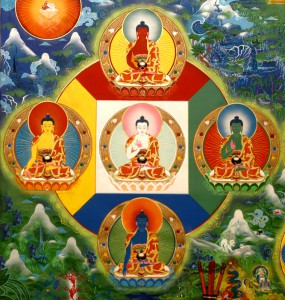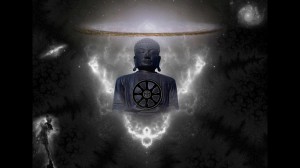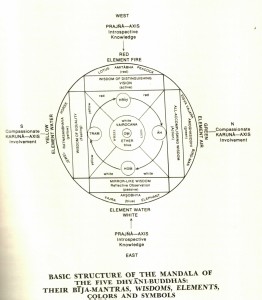THREE: THE MAṆḌALA OF THE FIVE DHYANĪ BUDDHAS
Then the Lord discoursed upon the Five Skandhas.
“Like an infernal Black Sun nailed to the dark fabric of space, *Mara’s Malignant Five hurl- forth their accursed aggregations of the no-self:
The Demons of Form, (Rupa) crawling along like concretized-crabs leaving their sensorial impressions where’re they creep…
The Demons of Sensation (Vendana), fumbling about upon weak-perceptional limbs, judging what’re they touch and perceive as pleasant or unpleasant feelings.
The Demons of Thought (Samjna), cognizing and labeling passing phenomena like aging botanists harboring their brittle specimens.
The Demons of Volition (Samskara), reacting to what they perceive with karmic-triggers that habitually keep them preoccupied incessantly playing the association game—thus making perpetual preconceived judgments.
The Demons of Consciousness (Vijnana), seeing and hearing and smelling and tasting and touching through the dark lens of the other combined skandhas—an exclusively empirical creature whose weak focusing ability (manas) carries it no further than the rotting storehouse (alaya-vijnana) from which it was conceived.”
*An interesting correlation here is Mara’s fivefold ills (Pañca-Mārā): continued existence, sin, death, karma, and the sinful angel or tempter[F.L.Woodward, Manual of a Mystic, pg.5]
Then the Bodhisattva Vajarpanī asked the Blessed One, “Is there no hope of release from these vile impediments?”
Whereupon the Blessed Vajradhara replied, “Five evils spawned from the black heart of the Evil One, Mara, are abjured only through the White-Wisdom Light of countless Tathagatas. The power of the Nefarious Five is turned-about through the Sacrosanct Five Dhyanī Buddhas Who emanate from the very heart of the Blessed Sugata.”
Thereupon the Lord began rotating the space about him with his humongous finger thus forming, like a whirling-dervish, the spherical outline of a majestic-maṇḍala. Within this miraculous creation the distinct shapes of the Five Dhyanī Buddhas steadily began to take shape:
From its eastern quadrant emerged the Royal-Blue shape of Akṣobhya Buddha. His right hand firmly touching the earth in immovable mudra (Bhūmisparsá-mudrá) fashion, while his left hand holds the Sacred Vajra, hovering about his palm. Akṣobhya reveals the Wisdom of the Great Mirror—a calm like quality resembling the placid surface of a vast blue-ocean. This is the cool and unattached objective gaze of the Dharmakaya, where even the darkest-corners of the alaya-vijnana are transmuted into Its Clear Light. Thus the Skandha of Consciousness takes a back-seat as all is dissolved away into the light-blue effervescence of pure-unadulterated Emptiness.
Buddha Ratnasambhava rises from the southern quadrant of the maṇḍala like a warm and vibrant Yellow-Sun, whose welcoming beams of light extend outwards from his upturned right hand and palm. Thus his sacred mudra (Dāna-mudrá) reveals the Wisdom of Equanimity. His blessed gaze equates everything with the Suchness of the Dharmadhatu; in so doing the Demon Skandha of feeling melts-away and is transmuted into the Transcendent Satisfaction of the One and Unborn. Pure Gold, wherein the innate core of authentic Selfhood celebrates the Real through the Real and nowhere else.
The Great Distinguishing Wisdom of Amitābha Buddha (color red)arises from the western quadrant, depicting the spiritual certitude of the inner-vision of a Blessed Tathagata with his folding hands mudra (Dhyāna-mudrá ) in meditative –style. The Skandhic-Demon of perception is thus lulled to sleep as the centric and eternal qualities of the Sugata, rises like a lotus-flower ascending from the skandha’s ignominious and murky depths.
Heralding from the northern quadrant of the transformational Maṇḍala of the Five Tathāgatas is Emerald-Green Amoghasiddhi Buddha. His striking Abhaya-mudrá (the raised hand) stops any advancing volitional-Demons dead in their tracks. He is the Lord of Karma and has the power, through his Wisdom that Accomplishes All Works, to reunite all polar-opposites—as exhibited through his Double Vajra (Viśvavajra). All former volitional activities are thus rendered karma-free.
Directly within the Maṇḍala’s center rests Vairocana Buddha (color white). All skandhic-forms are rendered ineffectual since he is the actualized-embodiment of the Dharmadhatu’s Element of Truth as represented through his Sacred Dharmachakra mudrá (upholding the self-same teaching symbol). Vairocana’s position is the very hub of the Tathāgata Family and fully embodies the Wisdom of the Universal Law.
Commentary
The Five Skandhas as well as the Five Dhyanī Buddhas play a recurring role in Vajrayana and the Sacred Tantra. This chapter has essentially introduced them and their interlocking associations. The basic outline of the Maṇḍala of the Five Tathagatas and their characteristics have been presented; in the subsequent chapter emphasis will be placed on their Sacred Mantras and how they correspond to and help to generate the inner-psychic channels of the sādhaka (the yogic practitioner). It’s interesting to note at this junction that the layout of the maṇḍala pictured above does not correspond to the usual geographical representation. Lama Anagarika Govinda writes in his marvelous book and invaluable resource (unfortunately out of print) Creative Meditation and Multi-Dimensional Consciousness the following:
“North, south, east, and west in a mandala are not indications of three- dimensional space but of movement within the inner-space of meditational experience. And this movement, like the course of the sun, begins in the east. Consequently, the entrance into the mandala is from its eastern quarter (Akṣobhya quadrant—inclusion mine), where the sun rises, in other words, from where the meditative experience starts…the movement from there proceeds clockwise, following the course of the sun, the left side of the mandala is designated as south, the right side as north, and the farthest point opposite the meditator as west.” (Govinda, pg. 61)
Gonvinda within the same resource offers the following depiction of the Five Dhyanī Buddha Maṇḍala, complete with all its characteristics: [CLICK-ON]



